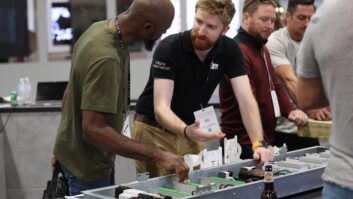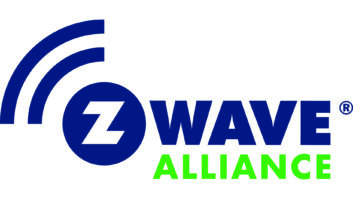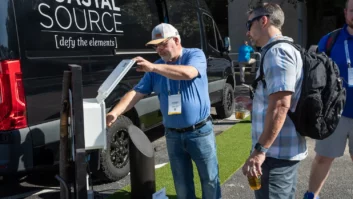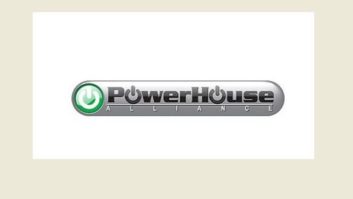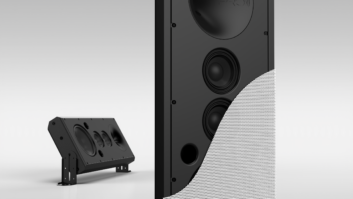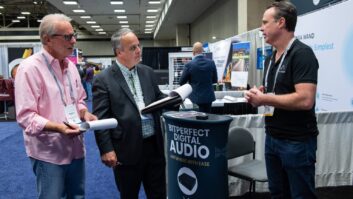The custom installation business in most parts of the country has proven immune to the first economic slowdown in almost a decade, and so has next month’s CEDIA Expo.
Although attendance at trade shows in other industries has fallen this year, CEDIA said attendance at the Sept. 5-9 event is forecasted to exceed last year’s 15,125 and perhaps will meet initial expectations of about 17,000, said trade show manager Don Gilpin.
The number of exhibitors will expand from last year’s 351 to 383 companies, whose plans include growing:
- the selection of products that combine control of distributed-AV systems and other home subsystems;
- the selection of two-zone and multizone receivers to lower the cost of acquiring a distributed-audio system;
- the selection of six- and 12-channel amps for distributed audio;
- the selection of DVD-Audio and multichannel-SACD players;
- and the selection of receivers and processors equipped with licensed THX EX and DTS ES decoders.
Suppliers will also expand the selection of receivers compatible with 6.1-channel DVD-Video soundtracks. (See page 28 for more details on upcoming launches.)
While CEDIA increases the size of its show, most installers and hybrid retail/installation companies continued to increase their custom-install revenues at healthy rates, even though retail sales and traffic have sagged. That’s the consensus of eight suppliers and eight installers polled by TWICE.
The installers attributed their success in large part to continued growth in new-home construction in most parts of the country. Some installers additionally cited their diversification into such disciplines as lighting, security and interior remodeling. And one hybrid retailer/installer, Ovation, based here, said its more aggressive custom stance, including new custom showrooms, may be contributing to “significant double-digit growth every month, except for one, when we were dead flat,” said marketing director Jeff Miller.
On top of that, installers who’ve targeted the ultra-wealthy, including Florida’s Audio Advisors, say paper losses in the stock market don’t affect the buying decisions of their clientele, which is made up of people living in $5 million homes.
Despite the industry’s “new-economy” performance, however, some installers have missed their targeted custom-install revenue projections, although their revenues have continued to grow, some installers and suppliers said. And in regions where the economies have been hit hard by high-tech industry turmoil and by the declining value of high-tech stocks, some installers have posted flat or declining revenues, marketers and installers said. In these markets, many potential customers could no longer depend on the value of their stock options to finance installations.
One of those markets is the Pacific Northwest, said Steve Hayes, CEDIA president and co-owner of Maine-based Custom Electronics. “We do work all over the country, and in the Northwest, things are off dramatically for everything,” he said. “Most of our business is still in the East and Northeast, and business there is still strong. We’re on plan, and we had a fairly aggressive growth plan.”
The industry’s relative strength, however, shouldn’t surprise most installers, given that many installers, though not all, continued to grow after the 1987 stock market crash and during the 1990-91 recession.
“I was at Audio King during the 1987 stock-market crash, and we braced for the worst, and on existing contracts, we saw a 4.5 percent cutback in dollar volume, and yet we met our targets because we still signed new contracts,” said Jeff Kussard, now Harman’s director of custom business development.
During the last recession, Audio Video Entertainment of Orange County, Calif., also increased its revenues, said creative director Bruce Fordyce.
What 2001 may prove, said Kussard, is that the industry has hit its stride. “In the homeowners’ minds, it’s not an extreme luxury item that they must be sold on anymore,” he said.
Despite the industry’s strong performance to date, some installers are still cautious about the short-term future. “We are tightening the screws and extinguishing debts,” Hayes said. Clients who are manufacturing industry executives are beginning to express concern about their economic future, he said.
Long term, the toughest challenge facing established installers might be growing competition from electricians, security installers and lighting installers who are diversifying.
“With all the communication and security people moving into A/V,” said Audio Advisors owner Jeff Hoover, “installers who get caught up in the commodity business, like future-proof structured wiring, will lose out to people, like electricians, with lower overhead structures.”
A growing number of competitors could be the source of the growing amount of competitive bids that installers such as Custom Electronics and Boston’s Media Systems are experiencing. “Clients are starting to have bid conversations, which we never had before,” said Custom’s Hayes.
Although Hayes isn’t sure why that’s happening, another installer attributes it in his Raleigh, N.C., market to more startup installation companies and to lighting installers who’ve diversified. “During the last few jobs, we’ve run up against more competitive bidding,” said Leon Shaw, president of Raleigh’s Audio Advice.
Despite layoffs by many high-tech companies in the area, “we’ll probably be up 20-25 percent like last year,” Shaw said. Although “a couple of theater jobs cancelled early in the year, most of them are back.” Because the new-home market is still strong, he added, “we haven’t had to target the retrofit market.”
Media Systems COO Eric Pikcilingis also noticed increased bidding activity on smaller jobs priced from $15,000 to $40,000 and attributes some of the increased activity to a growing number of competitors. Nonetheless, he attributes most of the increase in bidding activity to installers who have more time to seek out new projects because they’re experiencing slower growth or a drop-off in jobs.
If market demand is slowing, however, it hasn’t caught up with Media Systems yet. “We’re meeting our revenue goals [in Boston] and exceeding them in Palm Beach [where the company recently set up an office],” he said. In Boston, “We’re closing larger jobs than ever [at $200,000 plus] and more of them,” he said. “New England has weathered the economy well.” Nonetheless, he noted, “People are taking more time to decide whether to do something.”
Jon Robbins, co-owner of Hifi House Home Theater Centers in Broomall, Pa., said he hasn’t experienced more bidding competition, but he has seen “the very-high-end home theater business wane” in both retrofit and new-home installs. “My feeling is that a lot of this high-end business was the result of the stock market gains,” he said. “In the past 12 to 18 months, people who might have spent $100,000 on a home theater are going to $50,000.”
Nonetheless, “more new jobs are coming in,” and install revenues are rising about 10 percent to 15 percent.
Audio Video Entertainment and Home Entertainment Designs of Bonita Springs, Fla., are also enjoying more new jobs than they did last year.
For Audio Video, not only has the number of jobs increased, but so has the number of bigger jobs, thanks in part to the company’s diversification into disciplines outside audio and video, said creative director Fordyce. In man-hours, the company is 30 percent to 40 percent busier than last year “on top of a big jump last year,” he said.
Home Entertainment president Eric Bodley said he has 127 jobs in progress compared to 47 at the same time last year.
Only three of the eight suppliers interviewed pointed to mixed results at the installer level. Marketers at Harman, Home Systems Plus, Kenwood, Niles, Sonance and Russound pointed to continued growth at the installer level. Although “perhaps backlogs and lead times are not as far out as they once were, installers are still plenty busy,” said Russound marketing director Peter Hoagland.
Elan, MB Quart and Rotel described a picture that’s more mixed.
“Our sense is that the economy is more of a drag than we thought it would be in December,” said Paul Starkey, Elan’s executive VP of sales and marketing. Elan’s business is up 33 percent in the first seven months of the year, “but we thought it would be up 40-50 percent,” he said. Some Elan dealers are posting 100 percent revenue increases, while others are growing but more slowly than they did last year, he said. Some installers are slightly down.
MB Quart president Keith Lehman found installers “getting the same amount of new projects,” but more of them are less elaborate than in the past. Mike Bartlett, Rotel’s executive sales and marketing VP, said he sees “less new business” and “much less traffic” for installers.
Mitch Witten, recently promoted at Sonance to VP of marketing and product planning, admitted that installer-level business “has leveled off a little,” but there’s “no doom or gloom.”




